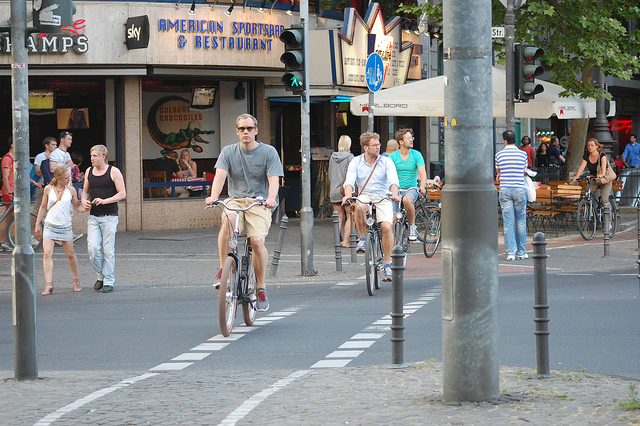
Who owns the city? A public “road space justice report” from Berlin

In many European urban centres, the full potential for cycling has not yet been realized. The simple reason is that towns and cities still primarily accommodate car users and neglect cyclists. “Re-allocating road space” is therefore a demand often heard from cycling advocacy groups, including ECF, without specifying to what extent this should be done. A study from Berlin took a closer look at this issue and came to some interesting conclusions.
When listing cycling-friendly big European cities, one name must not be missed out: Berlin. With a 15 % cycling mode share in 2012, it is the top cycling city in the category of more than 2 million inhabitants. Comparable capital cities like Rome, Madrid, Athens, Paris and London see cycling mode shares of only up to 3 %.
But does this mean conditions for cycling are perfect in Berlin? Certainly not.
A new report from Heinrich Strößenreuther from the Berlin-based “Agentur für clevere Städte” (Agency for smart cities) found that only 3 % of the cities’ public road space is dedicated to cycling. This compares with 58 % for motorized transport – a whopping 19 times more! Car parking on its own gets 19 % of the public road space, or 6 times more than cycling. Walking comes in at 30 %, thanks to the wide Berlin pavements.
In order to find these results, 20 students from the Best-Sabel University used inch rules to survey almost 200 streets across the city. The report claims that these 200 streets reflect a true space allocation of the entire Berlin city road network.
In order to find out whether this is a fair allocation of road space, the authors looked at the transport modal split. Cycling increased from 10 % in 1998 to 15 % in 2012. The political objective of the Berlin Senate is to achieve a cycling mode share of 20 % by 2025. This increase contrasts with the decline in car use; while the car still made up 38 % of all trips in 1998, it fell to 33 % in 2008 – and has further declined since.
The authors conclude that if politics were to take the cycling mode share objective seriously and fairly allocate public road space per user (i.e. the same amount of road space regardless of the mode of transport), cycling would need to see its dedicated space grow by 660 % over the next 11 years.
36 % of Berlin streets already have some sort of cycling infrastructure, a further 59 % don’t have yet but could have by shifting road space away from motorized transport. Only 5 % of Berlin streets were found to be too narrow to provide for dedicated cycling infrastructure, the report says. The authors however do not discuss whether cycling actually needs any dedicated infrastructures at all on roads with low speed and low motorized vehicle volumes (“Invisible cycling infrastructure”).
The report closes by suggesting solutions on how the extra space for cycling should be gained. Motorised transport would need less road capacity if the average speed was lowered. The authors also see a lot of potential in new mobility concepts and the sharing economy (car-sharing, bike sharing) as they can decouple car use from car ownership and therefore reduce the need for public car parking space. On average, a car in Berlin is driven for 31 minutes a day, or just 2.1 % of the day’s duration.
Agentur für clevere Städte, Heinrich Strößenreuther, Wem gehört die Stadt? Der Flächen-Gerechtigkeits-Report. Berlin, 2014 http://clevere-staedte.de/flaechen-gerechtigkeits-report-online
- Log in to post comments
Contact the author
Recent news!
Upcoming events
Contact Us
Avenue des Arts, 7-8
Postal address: Rue de la Charité, 22
1210 Brussels, Belgium









